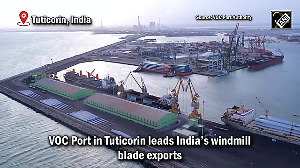Life has not always been so easy for Atul. He studied in a Marathi medium school where the culture of entrepreneurship was unheard of and getting a job was considered a better option than becoming a businessman.
"I enjoyed my school days because I had a great circle of friends. But what we lacked was an atmosphere that encouraged entrepreneurship. I'd have been four years ahead in what I am doing now," says 25-year-old Atul, "had they taught us some basics about starting a business."
Not one to be bogged down by such hurdles as having studied in a vernacular medium school and brought up in an atmosphere that shunted entrepreneurship, Atul succeeded in opening his own company, Innovation Trip, in partnership with his friend Anand Chhatbar in 2005.
"We at Innovation Trip act like a bridge that spans the gap between an innovative idea and its successful execution," says Atul about his company's core business. In other words, the company arranges for corporate executives to meet with idea innovators abroad and discuss these ideas one-on-one.
Though Atul spends most of his time in the US scouting for innovators willing to exchange ideas with bright minds across the world, he was in Pune recently and spoke of his business plans with rediff.com's Prasanna D Zore.
Tell us about your school and college days and your first business venture.
I studied in Parle Tilak Vidyalaya, a Marathi medium school in Vile Parle, a Mumbai suburb. Life was good there and thanks to the circle of friends I had I learned a lot about life. Having good friends around you plays a crucial role in shaping your personality. What we all lacked, however, was some kind of introduction to and training in entrepreneurship. Most of the children studying there came from middle-class Marathi families who preferred performing services rather than starting up their own businesses.
I completed my engineering course in Information Technology from the Sardar Patel College of Engineering. After completing the course I started working with i-Flex as a software engineer. I worked there for about a year and then quit to start Innovation Trip in 2005. Most of that year I planned meticulously to start Innovation Trip; I was only 23 at the time.
Before Innovation Trip happened, I obtained a diploma in computer engineering from the Government Polytechnic in Mumbai and Anand (Chhatbar) and me started a small enterprise. We developed applications for the Web, writing software programmes and selling them to companies. It was very difficult at that time to squeeze out our rightful payments from clients -- while it was a profitable venture, we had to push to receive dues for anything that we did. That was sort of a grounding for me to start my next enterprise, Innovation Trip.
So the next big thing was Innovation Trip. What was it like setting up the company?
The experience pretty much went according to plan. We realised that a lot of successful ventures in India were a copy of some overseas dotcom venture. We wanted to teach participants to look at innovation as a continuous process -- how to discover customer needs and brainstorm to find an innovative solution that met those needs in the form of a product.
We believe that India has a lot of grassroot innovations. But they don't materialise into successful businesses because bootstrapping a business is quite difficult in India. We train corporate executives to see innovation as a process. We have sessions with them on product prototyping, customer-centric innovation, how to identify customer needs, how to make companies innovation-oriented and how to develop cultural innovation.
We conduct these kinds of workshops with a company's executives in attendance. We take them on visits to organisations in the US like Ideo, the company that designed the palmtop, in Palo Alto. These sessions help people understand the importance of innovation and pioneering work in making a company successful.
What is Innovation Trip's business model?
We started Innovation Trip as an event model. We take corporate executives from all over the world to countries like the US, Australia and Latin America and have them train and interact with innovators abroad.
We arrange tours to various companies, facilitate their interaction with innovators in these organisations and help them exchange ideas. We had the chief technology officer of Hewlett Packard, Phil McKinney, exchange his views with our participants wherein he shared how innovation played an important role in HP's success.
Basically, it is a knowledge transfer exercise wherein people who are innovators and entrepreneurs come together and exchange ideas. While some ideas actually materialise into innovation, others act as catalysts for future innovation. We at Innovation Trip act like a bridge that spans the gap between an innovative idea and its successful execution.
Apart from Ideo and HP we've had our participants interact with those who have set up centres for companies like Pitney Bowes, a Fortune 500 company. If we can't schedule a company visit then we take them to visit people who have actually been a part of innovation at Fortune 500 companies.
What are the guiding principles that you follow at Innovation Trip?
First and foremost we have to make our customers feel that they are getting a bang for their buck. The learning that they take home from a tour abroad is worth what we charge them. And we make sure that we give them a great experience; we book luxury hotels and we spend a lot of money on the whole experience. At the same time we have to ensure that we make a profit.
So, is Innovation Trip making profits today? What's your revenue model?
Our revenues come from registration fees that every participant has to pay us for organising trips abroad. We charge around $9,000 per participant. That is the main contribution. Apart from that we receive money from companies that sponsor events like dinners, panel discussions, outbound trips etc.
We expect around $250,000 in revenues for the period ending December 2007. Even if we have not grown too fast in the revenue department up until now, we recently changed our revenue model and by the end of December 2008 we expect to quadruple that figure (that's $1 million).
We will achieve this figure by scaling down on our expenses and removing hurdles that prevent us from scaling our business model. Now, instead of arranging and scheduling an expert's lecture we let our participants have a one-on-one with a whole bunch of innovators where ideas are exchanged on a personal basis.
This reduces the cost of booking an auditorium and allows us to scale our business.
The profit margin we maintain is in the range of 30 to 40 percent, Innovation Trip being in an elite kind of business. We do spend a lot of money in giving our clients a holistic experience in innovation but then we also charge them accordingly.
Who are your corporate clients from India?
As of now we have 22 customers from India. Prominent amongst them are GEI Godavari Engineering from Hyderabad, BPI Engineering, UTI Logistics which is a multi-billion dollar logistics firm, Suchir India Group, a real estate group and a BSE-listed company Bartronics India.
Are you planning to raise money for scaling your operations anytime soon?
We are planning to raise some capital soon from private investors in India. Once the company attains a significant size, in say a couple of years, we want to take it public.
And how much would be a 'significant' size?
It will be worth at least $10 million and we are confident of achieving that target in the next 2-3 years. That should take our profits into the range of $3-$4 million by 2009-10.
Any advice for budding entrepreneurs in India?
India is a great place to do business but then there are lots of hurdles in bootstrapping a venture.
I'd advise young entrepreneurs to be more global in their outlook. Setting up a company and having it registered here is a tricky business. So I'd advise that entrepreneurs should have their companies registered abroad and then establish a subsidiary in India.
Even Innovation Trip works on that model. We have registered in the US and run a subsidiary in India. This helps us grow in appeal as an international company. India as a country is great to operate in because of its low costs.





